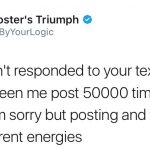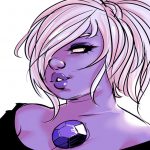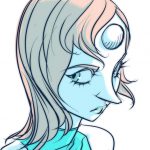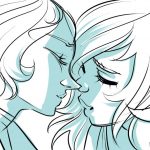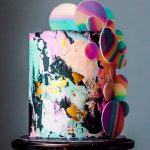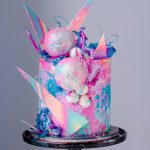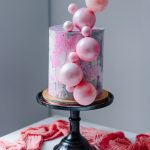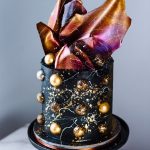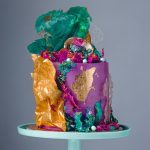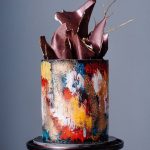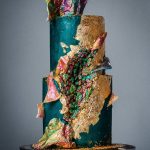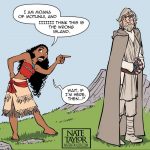I have a bachelor of fine art from Ohio State. :) My school didn’t have a cartooning program, so I concentrated in Art & Technology and learned how to make holograms and robots.
But before and since, the majority of my comics technique has been self taught.
Month: January 2018
Hello! I saw your old post about making buttons on your blog, and I want to say thanks for putting it together! it was the most comprehensive button guide I’ve read. I also had a quick question about the BAM hand press. When I try to make the 1.25 in buttons, the plastic cover sticks out / isn’t completely tucked into the pinback in some places. Have you had this problem? Do you have any tips against this?
I’m glad you found it helpful!
The cover-sealing issue is a common one I had when I first started out. I also have it sometimes now, as sometimes I get a slightly off/bad batch of parts now and then.
My best advice is to make sure you’re pressing the red disc in as flat and flush as possible. Some of my friends use a sledgehammer. Look at the back, and make sure you can see the edges of the paper and plastic all around the button face. (See steps 20 and 21 of the guide.)
23, 30,19
23: Do you draw more fanart, or more original art?
Original. I have a webcomic to maintain, so I’m working on that 90% of the time. I wish I had more time for fanart, but only a few things strike my fancy enough for me to draw fanart of it.
30: What inspires you to not just make art, but to be a better artist?
I think it can be summed up by the biggest lesson/advice I learned from one of my art professors: there is always more to learn.
There’s always something new to try out and fold into my arsenal.
19: What is the most difficult thing for you to draw?
DUDES. Seriously, I just try to get their proportions down and my brain gets all wibbly wobbly. WHERE DO THE HIPS GO. I’ve been drawing ladies for SO LONG, lol.
1 and 2? :3
1: Do you prefer traditional drawing, or digital?
I like both, but I tend to work in digital most of the time. My comics are all digital, as are most of my commissions, but it’s also nice to unplug and use traditional media now and then. My con sketch cards are markers, pen, and colored pencil, which are the supplies that I used most often as a teenager before I learned how to art with a computer, so there’s an element of nostalgia built in for me. :) I still have nearly every colored pencil I’ve owned since ager 14. ^_^;;
2: How long have you been drawing?
My mom would tell you I came out of the womb with a crayon in my hand. (ETA: If I recall correctly, the earliest drawing I did, as immortalized in my photo album at home, is from 1989 or 90. It was a picture of my mom.) I always liked to draw and was usually the best artist in my class in elementary school and the like.
But really, I mostly drew cats up until around 1998, when I discovered Sailor Moon. Then I started drawing PEOPLE, and I haven’t really stopped since.
I’ve been making comics since high school (2003ish), and I put up my first webcomic almost ten years ago.
14 (If so I’d love to know how), 22, and 24
14: Do you ever collaborate with others?
Rarely, and when it does happen, it’s usually just for shits and grins. For awhile, I was going to a weekly meetup of local comics folks and we’d do jam comics, for example. In a professional context, I’ve KIND of worked with writers (on my first webcomic, which was a collaboration between me and my two BFFs) but not in a long time. I’m A LONE WOLF WHO DON’T NEED NO ONE! jk. XD
22: Are you confident that you’re improving steadily?
Oh yes. Do something every day for a decade and you’ll go a long way from where you started.
24: Do you feel jealous when you see other people’s art, or inspired? (Be honest!)
BOTH. INTENSELY.
Going through my ask history because I knew there were a few things like this that would be good for my FAQ. :D
Untitled
Willem Arondeus was a Dutch resistance fighter who gave his life trying to protect his Jewish countrymen from the Nazis.
Born in Amsterdam in 1895, Willem was one of six children. From a young age, he was a talented artist and his parents encouraged his creativity, until he came out as homosexual at age 17.
In a time when nearly all gay people were in the closet, Willem’s parents could not accept his choice to live openly. Their rejection led Willem to run away from home.
On his own, Willem took odd jobs and eventually became a successful visual artist and writer. He was commissioned to paint a mural for Rotterdam’s town hall, in a style that combined modern abstract painting with a traditional Dutch motif. Willem was a well-respected author who published a popular biography of Dutch painter and political activist Matthijs Maris.
In 1940, Germany invaded the Netherlands. Willem immediately joined the resistance movement, and urged his fellow artists to fight against the Nazi occupation. WIllem published illegal anti-Nazi pamphlets calling for mass resistance against the Germans.
Willem was especially committed to saving Amsterdam’s Jewish community. Bringing in others to the cause, Willem arranged for Dutch Jews to be hidden in people’s homes. He used his artistic skills to create false identity papers.
In 1943, Willem hatched a brazen plan. Dressed as a German Army captain, and with 15 men behind him, Willem boldly marched into the Public Record Office, where lists identifying people as Jews were kept. Willem drugged the guards and planted a firebomb. The resulting blaze destroyed tens of thousands of documents, and delayed or prevented many Jews from being identified by the Nazis.
Unfortunately, Willem was captured by the Germans and sentenced to death. Willem’s last words before being executed in July, 1943 were, “Let it be known that homosexuals are not cowards.”
In 1986 Yad Vashem recognized Arondeus as Righteous Among the Nations.
Because of his sexual orientation, Willem’s story was omitted from Dutch history books. Only in the last 20 years has his courage become widely known.
Untitled
this should start off my faq tag nicely.
Untitled
sophie your art makes me sO MAD *peers at screen for the next 5 hours*

